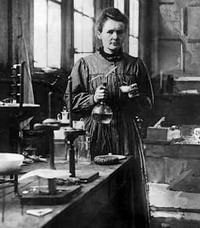Login form
Marie Curie
 At a time when women scientists were rare, Marie Curie probed the mysteries of radioactivity and X rays. In 1903, she and her husband won the Nobel Prize in physics, one of the most important awards in science. In 1911, Marie Curie won a second Nobel Prize, this time in chemistry. She is one of very few people in history to win two Nobel prizes.
At a time when women scientists were rare, Marie Curie probed the mysteries of radioactivity and X rays. In 1903, she and her husband won the Nobel Prize in physics, one of the most important awards in science. In 1911, Marie Curie won a second Nobel Prize, this time in chemistry. She is one of very few people in history to win two Nobel prizes.
MARIE CURIE’S EARLY LIFE
Marie Curie was born as Maria Sklodowska in Poland in 1867. Though Maria excelled in school, no university in Poland at that time allowed female students.
In 1891, Maria traveled to Paris, France. She called herself Marie, the French form of Maria. She attended the Sorbonne, a famous college in Paris. Marie studied physics and mathematics and graduated at the top of her class! She also met a French chemist named Pierre Curie. They married in 1895.
WHAT DID THE CURIES RESEARCH?
Marie and Pierre were pioneers in studying radioactivity. Radioactivity is a process in which certain elements, such as uranium, break down into other elements. In the process, they give off energy in the form of radiation. Marie and Pierre built on the work of Wilhelm Roentgen, who discovered X rays, and Antoine Henri Becquerel, who discovered radioactivity in the element uranium. X rays are a type of radiation.
The Curies discovered that a mineral called pitchblende was radioactive. Pitchblende contains uranium. But pitchblende gives off more radiation than uranium alone could. The Curies guessed that there must be other radioactive elements in the pitchblende.
The Curies separated huge amounts of pitchblende into its chemical parts—the elements it is made of. In July 1898, they reported the discovery of a new element called polonium. In December, they announced the discovery of another new element, radium.
MARIE CURIE GOES ON ALONE
In 1906, a horse-drawn carriage hit and killed Pierre. Marie stepped into his teaching post at the Sorbonne. She was the first woman to teach at the university. She poured her energy into research and raising her daughters. One daughter, Irene, followed her parents into scientific research. In 1914, the Sorbonne built a new laboratory to research radioactive materials. Today the laboratory is named after Marie Curie.
Marie Curie earned little money from her famous research. Her Nobel Prize money paid for more research. She did not patent—reserve for her own gain—her discoveries. She left them free for other scientists to use.
SERVICE IN WORLD WAR I
When war broke out in Europe in 1914, Marie Curie helped equip ambulances with X-ray machines. The International Red Cross named her its head of Radiological Service. She taught doctors how to use X rays to help wounded soldiers. X rays help doctors see inside the body so they can figure out what’s wrong with people.
CURIE’S RESEARCH AND HER HEALTH
Radiation in large doses poisons the body. Curie was exposed to radiation for years. At that time, no one knew that radiation was dangerous. Curie’s work gave her leukemia, a form of cancer. Marie Curie died on July 4, 1934. Today, an important result of Marie Curie’s research is the use of radiation to slow or destroy cancers.
Source: Microsoft ® Encarta

